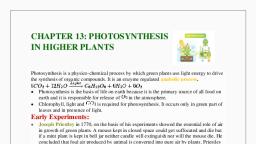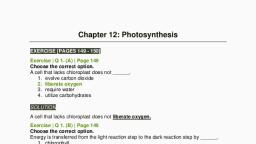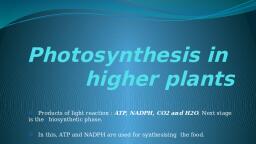Page 1 :
PHOTOSYNTHESIS IN, HIGHER PLANTS =<, , , , , , , , , CONCEPTS, , Green plants synthesise the food they need and all other organisms depend on them for their, food., , Green plants prepare their food through photosynthesis, a physico chemical process during, which they use light energy to drive synthesis of organic food., , The use of light energy by green plants is the basis of life on earth. It is the primary source of, all food on earth as well as responsible for release of Oy by green plants into the atmosphere., , 2eriments in Relation to Photosynthesis, , Joseph Priestley performed a series of experiments and proved that air is essential for the, growth of green plants., , e@ Discovered oxygen in 1774,, , © Priestley performed experiments with burning candle and mouse in closed space of bell jar, and found that plants restore to the air whatever burning candles and breathing animals, remove,, , » Foul air produced during burning of candle and breathing of animal (mice) could be, converted into pure air by plants., , an Ingenhousz proved that light is essential for photosynthesis (the process which purified the, ir fouled by burning candles or breathing animals)., , » Ingenhousz also proved that only green part of plants could release oxygen in presence of, sunlight., , n 1854, Julius Von Sachs proved that plants synthesize glucose when they grow and glucose, i stored as starch., , ' He also proved that chlorophyll is located in chloroplast., Sachs proved that green parts of plants are the site for glucose synthesis., , ‘W. Englemann described the first action spectrum of photosynthesis by using Cladophora, sreen algae) and a prism for splitting light into spectral components., , He found that maximum photosynthesis took place in presence of red and blue light of split, Spectrum,, , an Neil, a microbiologist proved that Oy, during photosynthesis, comes from water and not, om COg. He studied photosynthesis by green and purple sulphur bacteria and compared it, ith that of green plants., , He found that sulphur or sulphate was the product when HyS was used as hydrogen donor, similarly when HO was used as hydrogen donor, it got oxidized to Og., , aben, Hassid and Kamen used water with heavy isotope of oxygen O'* and proved that Oy, tring photosynthesis comes from water and not from COs., , oll’s half leaf experiment proved that COg is essential for photosynthesis and starch synthesis,, this experiment, KOH was used to absorb CO, within the bottle., , After all the experimentation, the correct equation for photosynthesis is, , 600, + 12,0 EE C,H,.0, + GH,O + 60,, , Photosynthesis in Higher Plants | 23
Page 2 :
yathesis,, 2. Site for Photosyat ;, fe Chloroplast is the site for photosymt, , rts of the plants,, Heophell calls of teaves possess a lange, , hesie, Ietakes place in the cells of leaves and other yee, thesis. 1Htakes, , , , number of chloroplasts which align themselyey, , alon, : ert ry, optimum quantity of incident light, , , , , , . hat they get, e mesophy tt cells such U : scent wally. 4, the walls of te ras aligned with their Oat surfaces paralle! ag ihe a Alls during the, 2 The chloroplast will Ye ae the strface in presenice of higher light intensity é., «ly, dicular to a, , morning and perpen, , midday hours,, Photosynthesis involves, , thylakoid membrane or grana, , s — light reaction which tak, » that takes place within stror, , ‘Outer membrane, , place Within, , , , two types of reactions, and dark reactior, , , , , , Inner membrane, , Stromal lamella, , Grana, , ‘Stroma, , Ribosomes, , Starch granule, , Lipid droplet, Fig. 21: Diagrammatic view of an electron micrograph of @ section of chloroplast, , 3. Pigments Involved in Photosynthesis, , For performing photosynthesis, green p!, different categories:, , {@ Chlorophyll—a, b,c. de, (@ Carotenoids (yellow to yellow orange), te a ditional type of photosynthetic pigment known as, .n algae possess an additional ty ", © as ed ee pean el gen rape), e Phycobilins are hot water soluble while other photosynthetic pigments are water insoluble, ‘® In chromatogram, chlorophyll-a provides bright blue green colouration and chlorophyll, provides yellow-green colouration. ;, The chlorophyll-a shows absorption peak in blue-violet and orange-red region of spectrum, , Chlorophyll-a is the chief pigment for photosynthesis., , ‘@ The other photosynthetic pigments like chlorophyll-b, xanthophyll and carotenoids are the, accessory pigments. These absorb light and transfer the energy to chl-a., These accessory pigments protect chlorophyll-a from photo-oxidation., , ‘© The chlorophyll-a molecule consists of 4 pyrol rings connected to each other through a centrally, placed Mg atom to form the head part and a phytol tail attached to the head through an ester, bond., , 4. Light Reaction, , Light reaction is the first part of photosynthesis. It involves conversion of light energy in!”, chemical energy by green plants., , © The chemical energy is in the form of ATP and NADPH., , © The light reaction involves following steps:, , ants possess variety of a pigments belonging to three, , , , , , 24 | Biology-XI: Term-2, , , , , , , , Absorption of light energy: The first step in light reaction is absorption of light by the various, pigment molecules. These pigment molecules are arranged in two groups forming light, harvesting complexes (LIIG). These are named in the sequence of discovery, (a) Photosystem 1(PS 1): Consisting, possess a special chlreaction,, (6) Photosystem II(PS I), P680 which forms the, © The chlorophyll, peak is at 680 nm., , @, , , , f about 230 chlorophyll molecules and 50 carotenoids. {1, , molecule P700 which forms the reaction centre, , , , , , nd take part in light, , , , , , consisting of similar pi, tion centr, , ments as PS L except one chl-a molecule, and take part in light reactions, , , , , , P700 has absorption peak at 700 nm and for cha P680 the absorption, , © The other pigments form the antenna molecules which perform absorption of different, wavelengths of light energy and transfer it to the reaction centres i.e. P700 and P6SO, through resonance methods., (i) Excitation of chl-a molecule and splitting of water: Light energy absorbed by antenna molecule, gets transferred to the reaction centre i., chlorophyll-a, which gets excited and looses electrons., © These electrons are picked up by an electron acceptor which passes them to an electron, transport system consisting of cytochromes ‘b’ and ‘f., © This movement of electrons is downhill in terms of redox potential seale, © The electrons released by PS IT possess excess, splitting of water molecule., 2H,O0 — 4H* +0, + 4e7, © The electrons released by splitting of water gets supplied to PS IT to fill up the electron gap, created by excitation of the P680, chl-a molecule., © PS 11 is physically located on the inner side of the thylakoid membrane. It means protons, and Oy are released in the lumen of thylakoid,, Transport of electrons and photophosphorylation, In presence of both longer and shorter wavelength, both PS I and PS II becomes functional, The reaction centre of both ic., P680 and P700 molecules get excited., © The electrons from PS IL is taken up by quinone and gets transferred to PS I with the help, of electron carriers including PQ (plastoquinone), cyt b, cyt fand plastocyanin., The electrons released by PS I get, accepted by phylloquinone molecules., These electrons then move downhill, again and get accepted by NADP*., The addition of these electrons reduces, NADP* to NADPH+H*. This is, catalysed by an enzyme NADP reductase, associated with photosystem (PS 1)., © The whole scheme of transfer of, electrons starting from PS II, uphill, to the acceptor, down the electron, transport chain to PS I, from PS 1, to another electron acceptor and, finally down hill to NADP* forming, NADPH +H” is called the *Z’ scheme, due to its characteristic shape., , , , , , € amount of energy which is responsible for, , , , , , , , , , Phostosystem II Phostosystem I, , NADPH., NADP, , —, H,0 —2e- + 2H* + {0}, Fig. 2.2: Z scheme of light reaction, , © The ‘Z’ scheme of electron transport was proposed by Hill and Bendall. This shape is, formed when alll the carriers are placed in sequence on a redox potential scale., , © The transport of electron during light reaction is of two types—, (@)_ Non cyclic electron transport represented by Z scheme and involving both PS Land PS IL, , Photosynthesis in Higher Plants | 25
Page 4 :
Atmosphere, | é, , CO, +H,0, , , , ‘Sucrose, starch, , Catvin cycie proceeds in three stages : (1) carboxylation, during which CO, combines with ribulose-1,5os a Sn ee aero formed at the expense of the photochemically made ATP and, < 1d again so that the, during which the CO, acceptor ribulose- 1,5-bisphosphate |s forme:, ‘(MADPH. and (3) regeneration apes, , aC, pathway (Hatch and Slack Pathway), ‘© This type of dark reaction is an adaptation to dry tropical regions and is a water conservation, sarategy. /, , The first CO, fixation product is a 4-carbon oxaloacetic acid, hence the name is C,-pa, , Plants performing C, pathway are C-plants, These are special plants due to:, , (0) Presence of a special type of Ieaf anatomy known as Kranz anatomy., , ©. Kranz means “wreath” and is a reflection of arrangement of cells., , C, plams possess large cells around the vascular bundles known as bundle sheath cell,, , These cells form several layers around the vascular bundles., , ‘© The bundle sheath cells are characterised by having a large number of chloroplasts, thick, suberised walls impervious to gaseous exchange and no intercellular space, Bundle sheath, , chlcroplast possess RuBisCO., , ® C, plants are capable of tolerating high temperature and flourish at high ligh, , (©) These lack the process of photorespiration., , (2) These show greater productivity of biomass,, , Maize, Sorghum (Jwar), sugarcane are examples of C, plants., , $n case of C, cycle, CO; fixation takes place twice-once in mesophyll cell cytoplasm and the, , other is in stroma of chloroplast of bundle sheath cells,, , © The fire tte product of Oe fixation is a C, acid, the oxaloacetic acid, hence the pathwi, is termed as C, pathway. The enzyme responsible for this fixa is PEPcase or PEP, carhoryase asthe scepnor molecule i phosphienoleyrivien ne, , , , , , tensity, , ee, , , , , , 28 | Biology-KI: Term-2, , , , , , , , , , , , , , , , , , , , CO,, (Atmospharic), Mesophyll cells Bundle Sheath celis, HCO} +PEP PEPcase Oxalo, = Acetic, ‘Acid (AC), — Malic (4C), AMP NADPH i Acid, Pyruvi Mapp? Malic, Dikinase Malic Decarboxylase, Acid, ate (acy es, 002, (cara, \ cycle, 3PGA Guiseae, Pyruvie Pyruvic, Acid Acid, (@c) (C,Acid), , , , , , , , , , , , Fig. 2.6: Diagrammatic representation of Hatch-Slack Pathway, , Several reactive steps are involved in C, cycle:, (a) Atmospheric CO, enters into mesophyll cell and dissolves in water to form HCO; which forms, the substrate for enzyme PEP carboxylase. HCO; ion condenses with phosphoenolpyruvate, (PEP) to produce oxaloacetic acid, a 4 carbon organic acid, (b) Second step involves conversion of oxaloacetic acid into another 4 carbon acids like malic, acid or aspartic acid. These get transported to bundle sheath cells through plasmodesmata., (©) Within bundle sheath cells, malic acid or aspartic acid undergoes decarboxylation to release, CO, and a 3-carbon acid (pyruvic acid) gets produced., (d) The pyruvic acid gets transported back to mesophyll cells where it reacts with ATP to form, phosphoenolpyruvic acid (PEP)., (¢) The CO4 released in the bundle sheath cells enters the Cal, enzyme RuBisCO and results into synthesis of glucose., In C, plants, RuBisCO is absent in mesophyll cells but present in bundle sheath cells while, PEPcase is present in mesophyll but absent in bundle sheath cells., © Calvin cycle occurs in all the mesophyll cells of C; plants, while in C, plants, it occurs only in, , bundle sheath cells, Thus Calvin cycle is common in all photosynthetic plants and glucose is, produced by only Calvin cycle., , , , , , cycle pathway in presence of, , , , © Number of ALP and NADPH required for the synthesis of one molecule of glucose through C,, pathway is 18 +12 = 30 ATP and 12 + 6 = 18 NADPH., Difference between C, and C, Plants, SNoe eG Plants, , , , , , , , 1 Ph ng Cy cycle only. Plants performing C, cycle., , Calvin cycle takes place in bundle sheath cel, , , , , , st is dimorphic, Mesophyll chloroplast, I while bundle sheath chloroplast. is, , , , , , , , , , , , , , Photosynthesis in Higher Plants \*
Page 5 :
30, , , , , , , , in mesophy, , guBisCO presen, " i ter high sun, , , , , , ‘optimum temperature,, , , , Photorespiration, release of CO» by g), , participation of three diffe, , , , e of sunlight, een plants in presence of sunlig, fo Excessive, e@ ltinvolves, , Mitochondria, @ During photorespir, presence ater concent?, , © The following diagram represents various st, , o, 200A, RuBisCO (Phosphoglyco!, croropiast REP net ns), = Soca, , Calin 5, Glucose Giycolic acid, , , , pst abundant enzyme on earth) behaves as oxygenase in, , ation, RuBisCO me the surroundings of a plant,, , on of oxygen, , , , , 1s in photorespiration:, , , , , , , , 2.1.02, , t GryoryleAed, Hydroxy Pyruvic Acid (2c), , “NHS |, ee, ee yin + Gyre, , CO;, Fig. 2.7; Diagrammatic representation of steps Involved In photorespiration, plants, Oy binds to RuBisCO and RuBP is converted to one, - of phosphoglycolic acid., aci, , , , Serine, (@o), , During photorespiration, in C, molecule of phosphoglyceric acid and one molec, The phosphoglycolic acid looses the phosphate radical to become glycolic, as respiratory substrate for photorespiration., , Jy colic acid enters into peroxisome and undergoes oxidation follow:, glycine which gets transported to mitochondria. /, Within mitochondria, two glycine molecules undergo decarboxylation to form one, of serine and one COp is lost. This is the excess CO, that comes out during photorespiration., The serine molecule comes back to peroxysome and undergoes deamination to yield back, glyceric acid molecule. ;, The glceric aid molecules undergoes phosphorylation to produce another 3-PGA molec, that enters into Calvin cycle., , In the photorespiratory pathway, there is no synthesis of sugars, ATP and NADPH. Ther, photorespiration is a wasteful process., , Lion, as they possess specific mechanism that increases concentrat, , , , , , which functions, , , , ed by amination to produce, , , , molecule, , , , cule, , , , , , , , Cy plants lack photoresp, at the enzyme site., , , , Biology-Xl: Term-2, , Due to lack, Factors Affecting Photosynthes, , , , , , tion, productivity of C, plants is greater than that of C, plai, , , , , , , , , , , , , , , , , , , , , , , , , , , , , , , , , , , , , , , , , , , , , , , , , , , , , Photosynthesis is under the influence of several factors both internal and external, I factors (plant factors) inc 1, size, age and orientation of leaves,, of chlorophyll present, upon the genetic predisposition and the growt, factors include the availability of sunlight, temperature, CO, concentration and water, Al factors affect a biochemical process, their effect is governed by two laws:, = Law of Minimum by Liebig: “The rate of metabolic process is limited by the pace of the, slowest, ® Blackman’s Law of Limiting Factors: When a process is conditioned as to its rapidity by, number of factors, the rate of the process is limited by the pace of slowest factor or the factor, which is nearest to its minimal value., (#) Light affecting photosynthesis, (a) Light intensity, © There is linear relationship between incident light and CO, fixation rates at low light, intensities., ¢ Most of the plants show light saturation at 10% of full day light intensity which is achieved, in the morning, So, light is, in dense forest, ¢ Excessive light intensity causes breakdown of chlorophyll, known, leading to decrease in photosynthe, (6) Duration of incident light: At normal light intensity, change in duration does not affect, y alters the amount of organic food synthesised, (©) Quality of light: The wavenlengths available for photosynthesis is important factor, rolling the rate as we know the maximum photosynthesis occurs in presence of red, (ii) CO, concentration affecting photosynthesis, , , , , , , © CO. ng factor for photosynthesis. The concenti " low, n the atmosphere 1.¢., 0.03 to 0.04 per cent. So, increase in concentration upto 0.05 per, cent cause an increase in ation rates., , # Increase in concentration beyond 0.05 per cent can become damaging over longer, periods., , # Cyand C, plants respond differently to CO, concentration . Atlow light intensity neither, Cy nor C, respond to high CO, concentration., , © Achigh light intensities, both C, and C, show increase in rate of photosynthesis., , , , , C, plants show saturation at about 360 pL" while Cy shows saturation beyond 450 plo!, Thus, current availability of CO, levels is limiting to the C, Cy plants respond to higher CO, concentration by showing increased rates of, hotosynthesis leading to higher productivity. This fact has been utilised for some, greenhouse crops such as tomatoes and bell pepper. These are allowed to grow in CO,, enriched atmosphere for higher yields., , , , plants., , , , , , , , , (iii) Temperature affecting photosynthesis, , © The various steps of dark reactions are enzymatic hence controlled by temperat, © The light reactions are also temp, , @ The Cy plants start performing photosynthesis just above 0°C. The op, for C, plants is 20-25°C and can perform photosynthesis upto about 35°C, , , , , , ture sensitive but they are afected toa much lesser, , , , ent, , , , n temperature, , , , Photosynthesis in Higher Plants | 31

































































